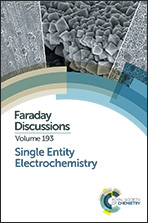Evidence for a hopping mechanism in metal|single molecule|metal junctions involving conjugated metal–terpyridyl complexes; potential-dependent conductances of complexes [M(pyterpy)2]2+ (M = Co and Fe; pyterpy = 4′-(pyridin-4-yl)-2,2′:6′,2′′-terpyridine) in ionic liquid†‡
Abstract
Extensive studies of various families of conjugated molecules in metal|molecule|metal junctions suggest that the mechanism of conductance is usually tunnelling for molecular lengths < ca. 4 nm, and that for longer molecules, coherence is lost as a hopping element becomes more significant. In this work we present evidence that, for a family of conjugated, redox-active metal complexes, hopping may be a significant factor for even the shortest molecule studied (ca. 1 nm between contact atoms). The length dependence of conductance for two series of such complexes which differ essentially in the number of conjugated 1,4-C6H4- rings in the structures has been studied, and it is found that the junction conductances vary linearly with molecular length, consistent with a hopping mechanism, whereas there is significant deviation from linearity in plots of log(conductance) vs. length that would be characteristic of tunnelling, and the slopes of the log(conductance)–length plots are much smaller than expected for an oligophenyl system. Moreover, the conductances of molecular junctions involving the redox–active molecules, [M(pyterpy)2]2+/3+ (M = Co, Fe) have been studied as a function of electrochemical potential in ionic liquid electrolyte, and the conductance–overpotential relationship is found to fit well with the Kuznetsov–Ulstrup relationship, which is essentially a hopping description.
- This article is part of the themed collection: Single Entity Electrochemistry


 Please wait while we load your content...
Please wait while we load your content...